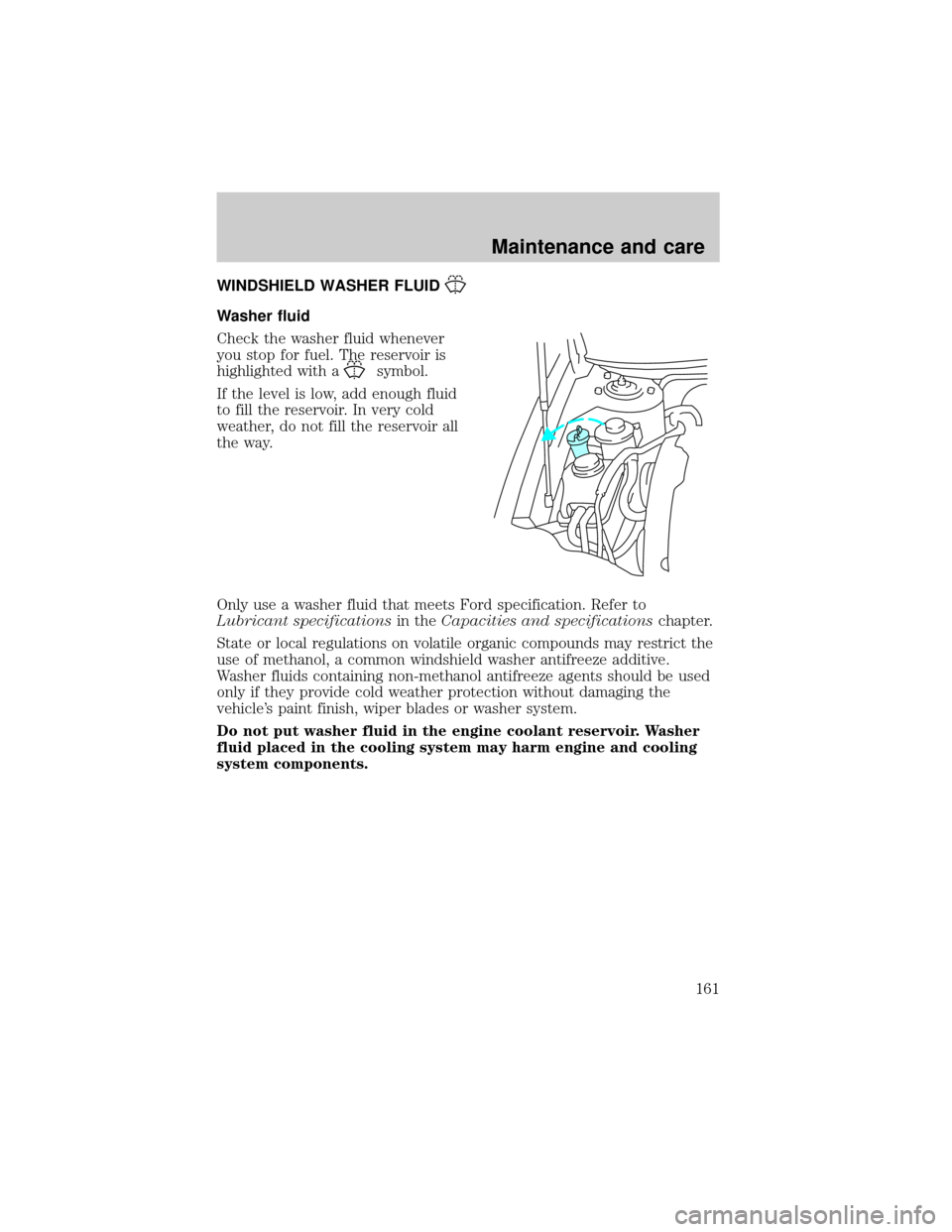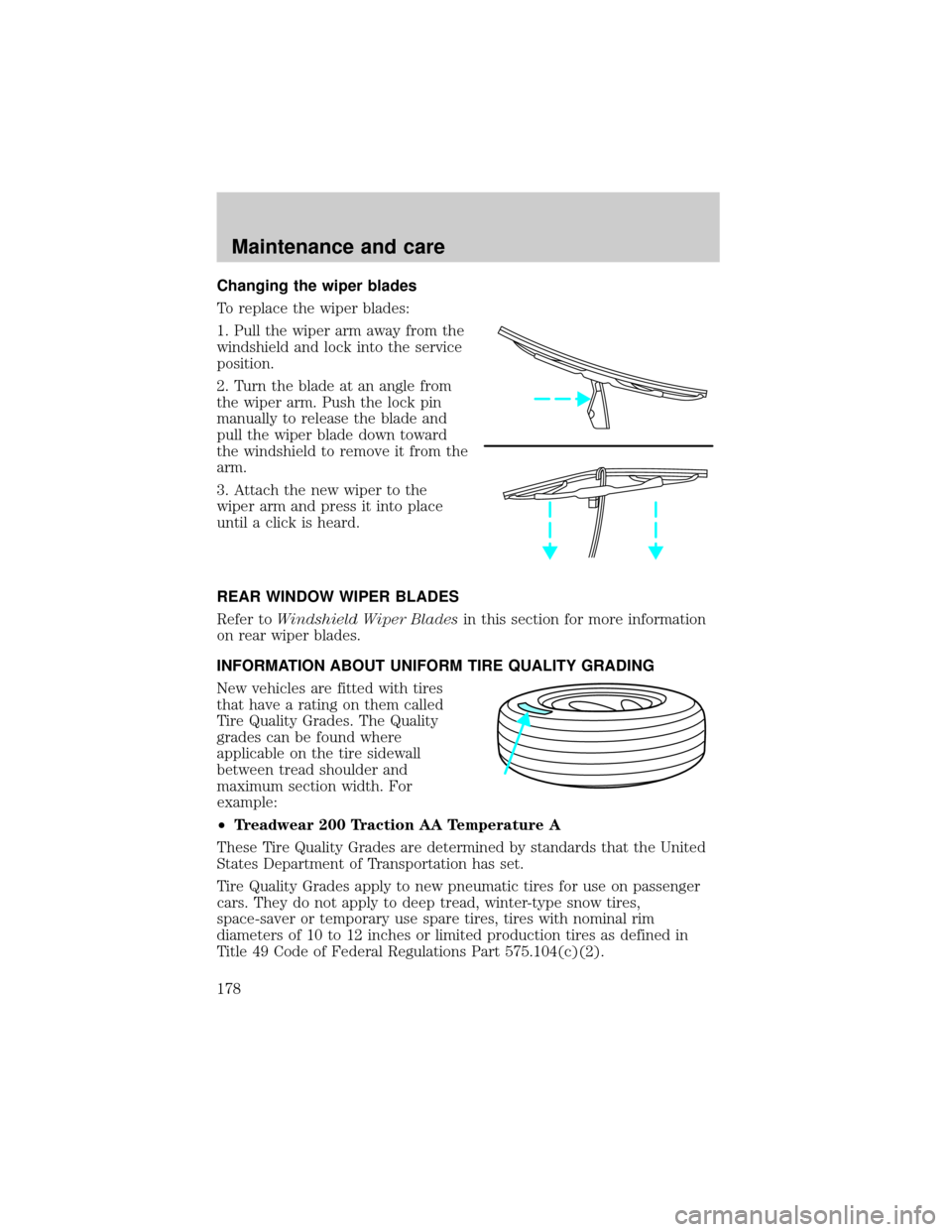wiper blades Mercury Sable 2001 Owner's Manuals
[x] Cancel search | Manufacturer: MERCURY, Model Year: 2001, Model line: Sable, Model: Mercury Sable 2001Pages: 240, PDF Size: 2.22 MB
Page 161 of 240

WINDSHIELD WASHER FLUID
Washer fluid
Check the washer fluid whenever
you stop for fuel. The reservoir is
highlighted with a
symbol.
If the level is low, add enough fluid
to fill the reservoir. In very cold
weather, do not fill the reservoir all
the way.
Only use a washer fluid that meets Ford specification. Refer to
Lubricant specificationsin theCapacities and specificationschapter.
State or local regulations on volatile organic compounds may restrict the
use of methanol, a common windshield washer antifreeze additive.
Washer fluids containing non-methanol antifreeze agents should be used
only if they provide cold weather protection without damaging the
vehicle's paint finish, wiper blades or washer system.
Do not put washer fluid in the engine coolant reservoir. Washer
fluid placed in the cooling system may harm engine and cooling
system components.
Maintenance and care
161
Page 177 of 240

2. Put the gearshift in P (Park), turn off all accessories and start the
engine.
3. Run the engine until it reaches normal operating temperature.
4. Allow the engine to idle for at least one minute.
5. Turn the A/C on and allow the engine to idle for at least one minute.
6. With your foot on the brake pedal and with the A/C on, put the
vehicle in D (Drive) and allow the engine to idle for at least one minute.
7. Drive the vehicle to complete the relearning process.
²The vehicle may need to be driven 16 km (10 miles) or more to
relearn the idle and fuel trim strategy.
²If you do not allow the engine to relearn its idle trim, the idle
quality of your vehicle may be adversely affected until the idle
trim is eventually relearned.
If the battery has been disconnected or a new battery has been installed,
the clock must be reset once the battery is reconnected.
²Always dispose of automotive
batteries in a responsible manner.
Follow your local authorized
standards for disposal. Call your
local authorized recycling center
to find out more about recycling
automotive batteries.
WINDSHIELD WIPER BLADES
Check the wiper blades at least twice a year or when they seem less
effective. Substances such as tree sap and some hot wax treatments used
by commercial car washes reduce the effectiveness of wiper blades.
Checking the wiper blades
If the wiper blades do not wipe properly, clean both the windshield and
wiper blades using undiluted windshield wiper solution or a mild
detergent. Rinse thoroughly with clean water. To avoid damaging the
blades, do not use fuel, kerosene, paint thinner or other solvents.
LEAD
RETURN
RECYCLE
Maintenance and care
177
Page 178 of 240

Changing the wiper blades
To replace the wiper blades:
1. Pull the wiper arm away from the
windshield and lock into the service
position.
2. Turn the blade at an angle from
the wiper arm. Push the lock pin
manually to release the blade and
pull the wiper blade down toward
the windshield to remove it from the
arm.
3. Attach the new wiper to the
wiper arm and press it into place
until a click is heard.
REAR WINDOW WIPER BLADES
Refer toWindshield Wiper Bladesin this section for more information
on rear wiper blades.
INFORMATION ABOUT UNIFORM TIRE QUALITY GRADING
New vehicles are fitted with tires
that have a rating on them called
Tire Quality Grades. The Quality
grades can be found where
applicable on the tire sidewall
between tread shoulder and
maximum section width. For
example:
²Treadwear 200 Traction AA Temperature A
These Tire Quality Grades are determined by standards that the United
States Department of Transportation has set.
Tire Quality Grades apply to new pneumatic tires for use on passenger
cars. They do not apply to deep tread, winter-type snow tires,
space-saver or temporary use spare tires, tires with nominal rim
diameters of 10 to 12 inches or limited production tires as defined in
Title 49 Code of Federal Regulations Part 575.104(c)(2).
Maintenance and care
178
Page 205 of 240

Any gasoline spilled on the vehicle or deposits such as bird droppings
should be washed and sponged off as soon as possible. Deposits not
removed promptly can cause damage to the vehicle's paintwork.
Remove any exterior accessories, such as antennas, before entering a car
wash. If you have wax applied to the vehicle at a commercial car wash, it
is recommended that you clean the wiper blades and windshield as
described inCleaning the wiper blades and windshield.
After washing, apply the brakes several times to dry them.
Underbody
Flush the complete underside of vehicle frequently. Keep body drain
holes unplugged. Inspect for road damage.
Waxing your vehicle
Waxing your vehicle on a regular basis will reduce minor scratches and
paint damage.
Wax when water stops beading on the surface. This could be every three
or four months, depending on operating conditions.
Use only carnauba or synthetic-based waxes. Use a cleaning fluid with a
clean cloth to remove any bugs before waxing your vehicle. Use tar
remover to remove any tar spots.
Avoid getting wax on the windshield, or on any surfaces which appear
coarse or bumpy. If you have wax applied at a commercial car wash, it is
recommended that you clean the wiper blades and windshield as
described inCleaning the wiper blades and windshield.
Repairing paint chips
Minor scratches or paint damage from road debris may be repaired with
the Ultra Touch Prep and Finishing Kit (#F7AZ-19K507±BA), Lacquer
Touch-up Paint (#ALBZ-19500±XXXXA), or Exterior Acrylic Spray
Lacquer (#ALAZ-19500±XXXXA) from the Ford Car Care Chemicals line.
Please note that the part numbers (shown as XXXX above) will vary with
your vehicle's specific coloring. Observe the application instructions on
the products.
Remove particles such as bird droppings, tree sap, insect remains, tar
spots, road salt and industrial fallout immediately.
Maintenance and care
205
Page 206 of 240

Cleaning the wheels
Wash with the same detergent as the body of your vehicle. Do not use
acid-based or alcohol-based wheel cleaners, steel wool, fuel or strong
detergents. Never use abrasives that will damage the finish of special
wheel surfaces. Use a tar remover to remove grease and tar.
The brushes used in some automatic car washes may damage the finish
on your wheels. Before going to a car wash, find out if the brushes are
abrasive.
Cleaning non-painted plastic exterior parts
Use vinyl cleaner for routine cleaning. Clean with a tar remover if
necessary. Do not clean plastic parts with thinners, solvents or
petroleum-based cleaners.
Cleaning mirrors
Do not clean your mirrors with a dry cloth or abrasive materials. Use a
soft cloth and mild detergent and water. Be careful when removing ice
from outside mirrors because you may damage the reflective surface.
Cleaning the exterior lamps
Wash with the same detergent as the exterior of your vehicle. If
necessary, use a tar remover such as Ford Extra Strength Tar and Road
Oil Remover (B7A-19520±AA).
To avoid scratching the lamps, do not use a dry paper towel, chemical
solvents or abrasive cleaners.
Cleaning the windshield, wiper blades and rear window
If the wiper blades do not wipe properly, clean the wiper blade rubber
element with undiluted windshield washer solution or a mild detergent.
To avoid damaging the blades, do not use fuel, kerosene, paint thinner or
other solvents.
If the wiper still does not wipe properly, this could be caused by
substances on the windshield or rear window such as tree sap and some
hot wax treatments used by commercial car washes. Clean the outside of
the windshield or rear window with a non-abrasive cleaner such as Ford
Ultra-Clear Spray Glass Cleaner, (E4AZ-19C507±AA), available from your
Ford Dealer.Do notuse abrasive cleansers on glass as they may cause
scratches. The windshield or rear window is clean if beads do not form
when you rinse it with water. The windshield, rear window and wiper
Maintenance and care
206
Page 232 of 240

Child safety seats ......................105
attaching with tether straps ..109
in front seat ............................106
in rear seat ......................106, 109
LATCH .....................................111
Cleaning your vehicle ...............204
engine compartment ..............207
exterior ....................................205
exterior lamps .........................206
instrument cluster lens ..........208
instrument panel ....................208
interior .............................208±209
mirrors .....................................206
plastic parts ............................206
safety belts ..............................209
washing ....................................204
waxing .....................................205
wheels ......................................206
windows ..................................209
wiper blades ............................206
woodtone trim ........................209
Climate control (see Air
conditioning or Heating) ............19
Clock ......................................35, 41
Console ........................................59
Controls
power seat .................................78
Coolant
checking and adding ..............162
refill capacities ................165, 211
specifications ..................212±213
Cruise control
(see Speed control) ....................47
Customer Assistance ................135
Ford accessories
for your vehicle ......................225
Ford Extended
Service Plan ............................217Getting assistance outside
the U.S. and Canada ..............224
Getting roadside assistance ...135
Getting the
service you need ....................217
Ordering additional
owner's literature ...................228
The Dispute
Settlement Board ...................220
Utilizing the Mediation/
Arbitration Program ...............223
D
Daytime running lamps
(see Lamps) ................................17
Defrost
rear window ..............................19
Dipstick
automatic
transmission fluid ...................168
engine oil .................................157
Doors
door ajar warning .......................9
lubricant specifications ..........212
Driving under special
conditions
through water .........................129
E
Emergencies, roadside
jump-starting ..........................147
Emission control system ..........190
Engine ........................................213
check engine/
service engine soon light ...........9
cleaning ...................................207
coolant .....................................162
Index
232
Page 236 of 240

child safety seats ....................105
cleaning ...........................208±209
SecuriLock passive
anti-theft system ...................73, 75
Servicing your vehicle ..............153
Spark plugs,
specifications .....................210, 213
Specification chart,
lubricants ...........................212±213
Speed control ..............................47
Speedometer ...............................14
Starting your vehicle ........113, 115
jump starting ..........................147
Steering wheel
tilting .........................................52
T
Tachometer .................................14
Tires ...........................143, 178±180
changing ..........................143±144
checking the pressure ............180
replacing ..................................181
rotating ....................................180
snow tires and chains ............181
tire grades ...............................179
treadwear ................................179
Towing .......................................130
recreational towing .................133
trailer towing ..........................130
wrecker ....................................152
Traction control ..................46, 121
active light ..................................8
Transaxle
automatic operation ...............123
fluid, refill capacities ..............211lubricant specifications ..........213
Transmission
fluid, checking and adding
(automatic) .............................168
lubricant specifications ..........212
Trip odometer .............................15
Trunk .........................61, 63±64, 76
remote release ..........................60
Turn signal ..............................8, 50
V
Vehicle dimensions ...................213
Vehicle Identification
Number (VIN) ...........................216
Vehicle loading ..........................128
Ventilating your vehicle ...........117
W
Warning chimes ...........................13
Warning lights (see Lights) .........8
Washer fluid ..............................161
Water, Driving through .............129
Windows
power .........................................56
rear wiper/washer .....................51
Windshield washer fluid and
wipers
checking and adding fluid .....161
checking and cleaning ....177±178
liftgate reservoir .....................162
operation ...................................50
replacing wiper blades ...........178
Wrecker towing .........................152
Index
236